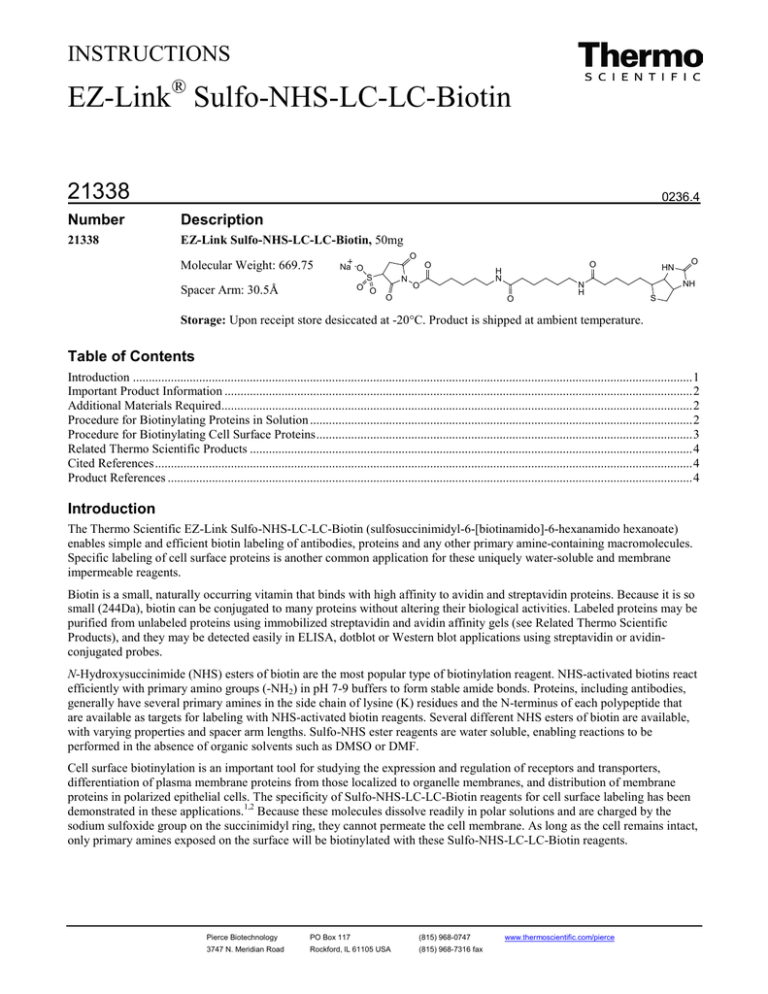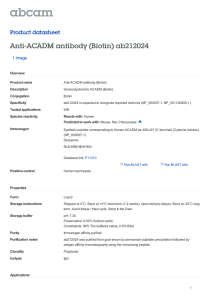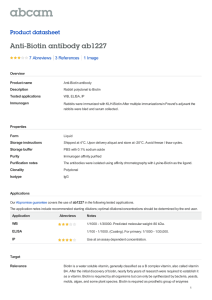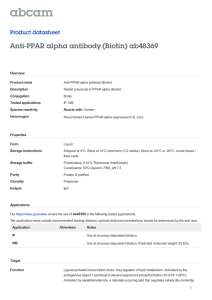
INSTRUCTIONS
EZ-Link® Sulfo-NHS-LC-LC-Biotin
21338
0236.4
Number
Description
21338
EZ-Link Sulfo-NHS-LC-LC-Biotin, 50mg
Molecular Weight: 669.75
O
O
Na -O
S
O O
Spacer Arm: 30.5Å
N
O
O
O
H
N
O
N
H
HN
O
NH
S
Storage: Upon receipt store desiccated at -20°C. Product is shipped at ambient temperature.
Table of Contents
Introduction ................................................................................................................................................................................. 1
Important Product Information .................................................................................................................................................... 2
Additional Materials Required..................................................................................................................................................... 2
Procedure for Biotinylating Proteins in Solution ......................................................................................................................... 2
Procedure for Biotinylating Cell Surface Proteins ....................................................................................................................... 3
Related Thermo Scientific Products ............................................................................................................................................ 4
Cited References .......................................................................................................................................................................... 4
Product References ...................................................................................................................................................................... 4
Introduction
The Thermo Scientific EZ-Link Sulfo-NHS-LC-LC-Biotin (sulfosuccinimidyl-6-[biotinamido]-6-hexanamido hexanoate)
enables simple and efficient biotin labeling of antibodies, proteins and any other primary amine-containing macromolecules.
Specific labeling of cell surface proteins is another common application for these uniquely water-soluble and membrane
impermeable reagents.
Biotin is a small, naturally occurring vitamin that binds with high affinity to avidin and streptavidin proteins. Because it is so
small (244Da), biotin can be conjugated to many proteins without altering their biological activities. Labeled proteins may be
purified from unlabeled proteins using immobilized streptavidin and avidin affinity gels (see Related Thermo Scientific
Products), and they may be detected easily in ELISA, dotblot or Western blot applications using streptavidin or avidinconjugated probes.
N-Hydroxysuccinimide (NHS) esters of biotin are the most popular type of biotinylation reagent. NHS-activated biotins react
efficiently with primary amino groups (-NH2) in pH 7-9 buffers to form stable amide bonds. Proteins, including antibodies,
generally have several primary amines in the side chain of lysine (K) residues and the N-terminus of each polypeptide that
are available as targets for labeling with NHS-activated biotin reagents. Several different NHS esters of biotin are available,
with varying properties and spacer arm lengths. Sulfo-NHS ester reagents are water soluble, enabling reactions to be
performed in the absence of organic solvents such as DMSO or DMF.
Cell surface biotinylation is an important tool for studying the expression and regulation of receptors and transporters,
differentiation of plasma membrane proteins from those localized to organelle membranes, and distribution of membrane
proteins in polarized epithelial cells. The specificity of Sulfo-NHS-LC-LC-Biotin reagents for cell surface labeling has been
demonstrated in these applications.1,2 Because these molecules dissolve readily in polar solutions and are charged by the
sodium sulfoxide group on the succinimidyl ring, they cannot permeate the cell membrane. As long as the cell remains intact,
only primary amines exposed on the surface will be biotinylated with these Sulfo-NHS-LC-LC-Biotin reagents.
Pierce Biotechnology
PO Box 117
(815) 968-0747
3747 N. Meridian Road
Rockford, lL 61105 USA
(815) 968-7316 fax
www.thermoscientific.com/pierce
Important Product Information
•
Sulfo-NHS-LC-LC-Biotin is moisture-sensitive. Store the vial of biotin reagent at -20°C with desiccant. To avoid
moisture condensation onto the product, equilibrate vial to room temperature before opening.
•
As directed in the procedure, dissolve the biotin reagent immediately before use. The NHS-ester moiety readily
hydrolyzes and becomes non-reactive; therefore, weigh and dissolve only a small amount of the reagent at a time, and do
not prepared stock solutions for storage. Discard any unused reconstituted reagent.
•
Avoid buffers containing primary amines (e.g., Tris or glycine) as these will compete with the reaction (see Figure 2). If
necessary, dialyze or otherwise desalt to exchange the protein sample into an amine-free buffer such as phosphate
buffered saline (PBS; see Related Thermo Scientific Products).
•
When biotinylating proteins in solution, excess non-reacted biotin and reaction byproducts are easily removed by size
exclusion using either desalting columns or dialysis (See Additional Information and Related Thermo Scientific
Products). A 10mL desalting column is best suited for processing biotinylation reactions involving 1-10mg of protein in
approximately 0.5-2mL. For smaller amounts of protein and/or smaller reaction volumes, both the biotinylation reaction
and subsequent buffer exchange may be performed in a single Thermo Scientific Slide-A-Lyzer MINI Dialysis Unit. For
larger reaction volumes than can be processed with a desalting column, either split the sample between two columns or
use an appropriate Slide-A-Lyzer® Dialysis Cassette for buffer exchange steps.
Additional Materials Required
•
Phosphate-buffered Saline (PBS) or other amine-free buffer having pH 7-8 for use as reaction buffer (see Important
Product Information and Related Thermo Scientific Products)
•
Desalting columns or dialysis units for buffer exchange (see Important Product Information and Related Thermo
Scientific Products)
Procedure for Biotinylating Proteins in Solution
A. Calculations
The extent of biotin labeling depends on the distribution of amino groups on the protein, and the concentration and amount of
protein to be labeled. By using the appropriate molar ratio of biotin to protein, the extent of labeling can be controlled.
Compared to reactions involving concentrated protein solutions, labeling reactions with dilute solutions require a greater fold
molar excess of biotin reagent to achieve the same incorporation level. Generally, use ≥ 12-fold molar excess of biotin for
proteins at 2-10mg/mL or ≥ 20-fold molar excess of biotin for proteins at ≤ 2mg/mL. Adjust the molar ratio of biotin reagent
to protein to obtain the level of incorporation desired.
1.
Calculate millimoles of biotin reagent to add to the reaction for a 20-fold molar excess:
mL protein ×
mg protein
×
mL protein
•
2.
mmol protein
×
20 mmol Biotin
mg protein
= mmol Biotin
mmol protein
20 = Molar fold excess of biotin for 2 mg/ml protein sample
Calculate microliters of 10mM biotin reagent solution (prepared in Step B.3) to add to the reaction:
mmol Biotin ×
1,000,000 μL
L
×
L
10 mmol
= μL Biotin
Example: For 1mL of a 2mg/mL IgG (150,000 MW) solution, ~27µL of 10mM biotin reagent will be added.
1 mLIgG ×
2 mg IgG
×
1 mL IgG
1 mmol IgG
×
20 mmol Biotin
150,000 mg IgG
0.000266 mmol Biotin ×
= 0.000266 mmol Biotin
1 mmol IgG
1,000,000 μL
L
×
L
10 mmol
= 26.6 μL Biotin Reagent
Pierce Biotechnology
PO Box 117
(815) 968-0747
3747 N. Meridian Road
Rockford, lL 61105 USA
(815) 968-7316 fax
2
www.thermoscientific.com/pierce
B. Biotin Labeling Reaction
1.
Remove the vial of biotin reagent from freezer and equilibrate it to room temperature before opening in step 3.
2.
Dissolve 1-10mg protein in 0.5-2.0mL PBS according to the calculation made in section A.
Note: Protein that is already dissolved in amine-free buffer at pH 7.2-8.0 may be used without buffer exchange or
dilution with PBS. Proteins in Tris or other amine-containing buffers must be exchanged into a suitable buffer.
3.
Immediately before use, prepare a 10mM solution of the biotin reagent by dissolving 2.0mg reagent in 300µL of
ultrapure water.
4.
Add the appropriate volume (see Calculations in section A) of 10mM biotin reagent solution to the protein solution.
5.
Incubate reaction on ice for two hours or at room temperature for 30 minutes.
Note: Other than the possibility of ordinary protein degradation or microbial growth, there is no harm in reacting longer
than the specified time.
6.
Protein labeling is complete at this point, and although excess non-reacted and hydrolyzed biotin reagent remains in the
solution, it is often possible to perform preliminary tests of the labeled protein by ELISA or Western blot. Once proper
function and labeling of the protein has been confirmed, the labeled protein may be purified for optimal performance and
stability using desalting or dialysis. If the Pierce® Biotin Quantitation Kit (HABA assay; see Related Thermo Scientific
Products) will be performed to determine the level of biotin incorporation, the protein first must be desalted or dialyzed
to remove non-reacted biotin.
Procedure for Biotinylating Cell Surface Proteins
Many variations of this procedure exist in the literature (see Product References). Labeling may be performed on cells in
suspension or on adherent cells in culture plates. In the latter situation, diffusion of the Sulfo-NHS-LC-LC-Biotin Reagent to
all surfaces of the cells will be limited, and labeling will occur predominately on the exposed surface. Culture media must be
washed from the cells; otherwise, amine-containing components will compete and quench the reaction to cell surface
proteins. Using a more concentrated cell suspension is most effective because less biotin reagent is required in the reaction.
Generally, a final concentration of 2-5mM Biotin Reagent is effective. NHS reactions occur more rapidly at higher pH;
therefore, pH 8.0 is used in the following example so that labeling can be completed as quickly as possible.
1.
Wash cells three times with ice-cold PBS (pH 8.0) to remove amine-containing culture media and proteins from the cells.
2.
Suspend cells at a concentration of ~25 × 106 cells/mL in PBS (pH 8.0).
3.
Add 1.0mg of Sulfo-NHS-LC-LC-Biotin reagent per mL of cell suspension (results in ~2mM biotin reagent).
Alternatively, add 200µL of the 10mM biotin reagent solution (see step B.3 on previous page) per mL of cell suspension.
4.
Incubate reaction mixture at room temperature for 30 minutes.
Note: Performing this incubation at 4°C may reduce active internalization of the biotin reagent.
5.
Wash cells three times with PBS plus 100mM glycine to quench and remove excess biotin reagent and byproducts.
6.
Lyse and/or analyze biotin-labeled cells as required for the research method.
Additional Information
Please visit the website for additional information including the following:
• Tech Tip #14: Perform labeling and other reactions in Slide-A-Lyzer Dialysis Cassettes
•
Tech Tip #43: Protein stability and storage
•
HABA Calculator for computing the results associated with the HABA assay measurements
Pierce Biotechnology
PO Box 117
(815) 968-0747
3747 N. Meridian Road
Rockford, lL 61105 USA
(815) 968-7316 fax
3
www.thermoscientific.com/pierce
Related Thermo Scientific Products
28372
BupH™ Phosphate Buffered Saline Packs, 40 pack
69576
Slide-A-Lyzer MINI Dialysis Unit Kit
66382
Slide-A-Lyzer Dialysis Cassette Kits
89890
Zeba™ Spin Desalting Columns, 7K MWCO, 2mL, 25 columns
89892
Zeba Spin Desalting Columns, 7K MWCO, 5mL, 25 columns
89894
Zeba Spin Desalting Columns, 7K MWCO, 10mL, 25 columns
28005
Pierce Biotin Quantitation Kit
20347
Streptavidin Agarose Resin, 2mL
20228
Pierce Monomeric Avidin Agarose, 5mL
21126
Streptavidin, Horseradish Peroxidase Conjugated, 1mg
21445
EZ-Link Sulfo-NHS-SS-Biotinylation Kit
21945
EZ-Link Micro Sulfo-NHS-SS-Biotinylation Kit
21925
EZ-Link Micro Sulfo-NHS-Biotinylation Kit
21935
EZ-Link Micro Sulfo-NHS-LC-Biotinylation Kit
21326
EZ-Link Sulfo-NHS-Biotin, No-Weigh™ Format, 8 × 1mg microtubes
21328
EZ-Link Sulfo-NHS-SS-Biotin, No-Weigh Format, 8 × 1mg microtubes
21329
EZ-Link NHS-PEO4-Biotin, No-Weigh Format, 8 × 2mg microtubes
21327
EZ-Link Sulfo-NHS-LC-Biotin, No-Weigh Format, 8 × 1mg microtubes
Cited References
1.
2.
Daniels, G.M. and Amara, S.G. (1998). Selective labeling of neurotransmitter transporters at the cell surface. Methods Enzymol 296:307-18.
Huh, K-H. and Wenthold, R.J. (1999). Turnover analysis of glutamate receptors identifies a rapidly degraded pool of the N-methyl-D-aspartate receptor
subunit, NR1, in cultured cerebellar granule cells. J Biol Chem 274:151-7.
Product References
Ali, M.K. and Bergson, C. (2003). Elevated intracellular calcium triggers recruitment of the receptor cross-talk accessory protein calcyon to the plasma
membrane. J Biol Chem 278(51):51654-63.
Borroto, A., et al. (2003). Impaired trafficking and activation of tumor necrosis factor-α-converting enzyme in cell mutants defective in protein ectodomain
shedding. J Biol Chem 278(28):25933-9.
Chyung, J.H. and Selkoe, D.J. (2003). Inhibition of receptor-mediated endocytosis demonstrates generation of amyloid β-protein at the cell surface. J Biol
Chem 278(51): 51035-43.
Frickel, E-M., et al. (2002). TROSY-NMR reveals interaction between Erp57 and the tip of the calreticulin P-domain. PNAS 99(4):1954-9.
Gimferrer, I., et al. (2003). The accessory molecules CD5 and CD6 associate on the membrane of lymphoid T cells. J Biol Chem 278(10):8564-71.
Li, H. and Pajor, A.M. (2003). Mutagenesis of the N-glycosylation site of hNaSi-1 reduces transport activity. Am J Physiol Cell Physiol 285:C1188-96.
Lukashevich, I.S., et al. (2003). Arenavirus-mediated liver pathology: acute lymphocytic choriomeningitis virus infection of rhesus macaques is
characterized by high-level interleukin-6 expression and hepatocyte proliferation. J Virol 77(3):1727-37.
Ohnishi, T., et al. (2003). MD-2 is necessary for the toll-like receptor 4 protein to undergo glycosylation essential for its translocation to the cell surface.
Clin Diagn Lab Immunol 10(3):405-410.
Pierce Biotechnology
PO Box 117
(815) 968-0747
3747 N. Meridian Road
Rockford, lL 61105 USA
(815) 968-7316 fax
4
www.thermoscientific.com/pierce
This product (“Product”) is warranted to operate or perform substantially in conformance with published Product specifications in effect at the time of sale,
as set forth in the Product documentation, specifications and/or accompanying package inserts (“Documentation”) and to be free from defects in material and
workmanship. Unless otherwise expressly authorized in writing, Products are supplied for research use only. No claim of suitability for use in applications
regulated by FDA is made. The warranty provided herein is valid only when used by properly trained individuals. Unless otherwise stated in the
Documentation, this warranty is limited to one year from date of shipment when the Product is subjected to normal, proper and intended usage. This
warranty does not extend to anyone other than the original purchaser of the Product (“Buyer”).
No other warranties, express or implied, are granted, including without limitation, implied warranties of merchantability, fitness for any particular
purpose, or non infringement. Buyer’s exclusive remedy for non-conforming Products during the warranty period is limited to replacement of or
refund for the non-conforming Product(s).
There is no obligation to replace Products as the result of (i) accident, disaster or event of force majeure, (ii) misuse, fault or negligence of or by Buyer, (iii)
use of the Products in a manner for which they were not designed, or (iv) improper storage and handling of the Products.
Current product instructions are available at www.thermoscientific.com/pierce. For a faxed copy, call 800-874-3723 or contact your local distributor.
© 2011 Thermo Fisher Scientific Inc. All rights reserved. Unless otherwise indicated, all trademarks are property of Thermo Fisher Scientific Inc. and its
subsidiaries. Printed in the USA.
Pierce Biotechnology
PO Box 117
(815) 968-0747
3747 N. Meridian Road
Rockford, lL 61105 USA
(815) 968-7316 fax
5
www.thermoscientific.com/pierce






![Anti-Syndecan-1 antibody [B-A38] (Biotin) ab27362 Product datasheet 1 Image Overview](http://s2.studylib.net/store/data/012079789_1-223f7b95ed918f034ac8bc18962af293-300x300.png)